Dancin’ Nekkid with the Angels
 Howard Cruse has received a bit of attention recently for Stuck Rubber Baby, his graphic novel about a white gay man coming of age in the racist American South of the 1960’s. Before that, he was well known in the gay and lesbian community as the creator of Wendel, a full-page strip
Howard Cruse has received a bit of attention recently for Stuck Rubber Baby, his graphic novel about a white gay man coming of age in the racist American South of the 1960’s. Before that, he was well known in the gay and lesbian community as the creator of Wendel, a full-page strip  that ran in the biweekly national gay newsmagazine The Advocate. But before that, Cruse had already been active for some time in the world of underground comix.
that ran in the biweekly national gay newsmagazine The Advocate. But before that, Cruse had already been active for some time in the world of underground comix.
Dancin’ Nekkid with the Angels (published back in 1987) is a collection of pieces from this period of his career. It spans more than a decade, and shows a noticeable evolution in both his style and his subject matter. The most obvious example of this evolution is that around 1980, Cruse came out, and started writing about life as a gay man.
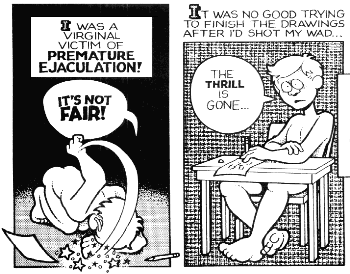 Cruse is known today almost exclusively as a “gay cartoonist”, but by the time of his coming out, he was already well known (in underground comix circles) as just a “cartoonist”. Which is not to say that his earlier work didn’t often have sexual content; it just wasn’t homosexual content. This collection includes several of those closeted works (as well as some out-of-the-closet pieces without an obvious “gay angle” to them). His art on the earlier pieces is simple, cute, and cartoony, reminiscent of his even-earlier strip Barefootz.
Cruse is known today almost exclusively as a “gay cartoonist”, but by the time of his coming out, he was already well known (in underground comix circles) as just a “cartoonist”. Which is not to say that his earlier work didn’t often have sexual content; it just wasn’t homosexual content. This collection includes several of those closeted works (as well as some out-of-the-closet pieces without an obvious “gay angle” to them). His art on the earlier pieces is simple, cute, and cartoony, reminiscent of his even-earlier strip Barefootz.
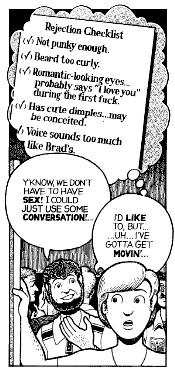 “Billy Goes Out” is one of the classic Cruse stories reprinted here. It was written in 1980, before AIDS cast its pall over gay male subculture. But rather than celebrating a time that people now look back at with nostalgia, it paints a somber, sobering picture of one young man’s life. It follows Billy going out for the evening. Each panel is two images: Billy doing the bar scene, and Billy’s thoughts at the time, often reflecting or contrasting each other. Taken together, they paint a haunting picture of a life filled with hurt, as Billy desperately searches for intimacy in the form of sex, while denying himself the real intimacy of a loving friendship or relationship.
“Billy Goes Out” is one of the classic Cruse stories reprinted here. It was written in 1980, before AIDS cast its pall over gay male subculture. But rather than celebrating a time that people now look back at with nostalgia, it paints a somber, sobering picture of one young man’s life. It follows Billy going out for the evening. Each panel is two images: Billy doing the bar scene, and Billy’s thoughts at the time, often reflecting or contrasting each other. Taken together, they paint a haunting picture of a life filled with hurt, as Billy desperately searches for intimacy in the form of sex, while denying himself the real intimacy of a loving friendship or relationship.
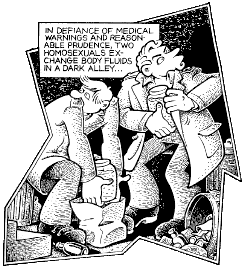 The story takes on additional poignancy a few years (and several pages) later. Another piece, called “Safe Sex”, is a rather jumbled piece filled with wry gags. On the last page is a small dark panel in which a man declares, “Billy’s dead.”
The story takes on additional poignancy a few years (and several pages) later. Another piece, called “Safe Sex”, is a rather jumbled piece filled with wry gags. On the last page is a small dark panel in which a man declares, “Billy’s dead.”
This is one of Cruse’s strengths, an ability to combine humour with pathos, kinky sex with innocence, and rage with thoughtfulness. Similarly, the style of his art adapts to the material, ranging from Peanuts-level simplicity to Warner-Bros-style exaggerated slapstick to, um, straight realism. As a general rule of thumb, Cruse has been moving away from the simpler art style of his early days, but he still switches, mixes, and matches art styles from one piece to the next.
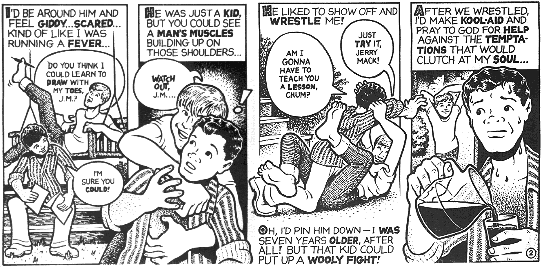
One piece that foreshadows some of the themes and subject matter of Stuck Rubber Baby is “Jerry Mack”. It’s a five-page story about the fictional life of Jerry Mack Wyatt, a homophobic evangelical minister. You might expect it to be a negative hatchet job, but it’s actually a very sympathetic story. It’s narrated by Jerry Mack himself, from the viewpoint of a devout but troubled man, reflecting on his past friendship when he was a young man with an artistic teenager named Evan Bond. It gets into the preacher’s head rather effectively, and we see how certain misunderstandings about that friendship with Evan led him to where he is today. By the end, Jerry Mack stands out as perhaps an equal victim of the homophobia his ilk are usually accused of creating.
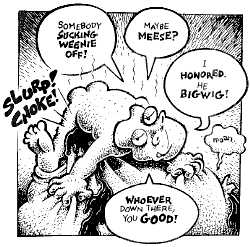 Perhaps the most overtly bitter piece is “Creepy Snuff Porn”, written as a challenge to the censorship movement and the scare tactics it uses. In it, a hideous little creature takes the members of the Meese Commission on Pornography (a paranoid panel put together by the Reagan administration, which blamed stroke books for everything except tooth decay), puts them in a bag, then proceeds to rape and kill them through holes in the bag… not necessarily in that order. It’s deliberately disgusting and offensive, but makes the point that the Meese Commission itself was (and still is) even more so. (And by comparison, it makes the work of Mike Diana, the current poster child for both the censorship and the anti-censorship movements, look like the untalented juvenile hack work that it is.)
Perhaps the most overtly bitter piece is “Creepy Snuff Porn”, written as a challenge to the censorship movement and the scare tactics it uses. In it, a hideous little creature takes the members of the Meese Commission on Pornography (a paranoid panel put together by the Reagan administration, which blamed stroke books for everything except tooth decay), puts them in a bag, then proceeds to rape and kill them through holes in the bag… not necessarily in that order. It’s deliberately disgusting and offensive, but makes the point that the Meese Commission itself was (and still is) even more so. (And by comparison, it makes the work of Mike Diana, the current poster child for both the censorship and the anti-censorship movements, look like the untalented juvenile hack work that it is.)
In case you hadn’t guessed, I’m a real fan of Cruse’s work. I looked forward to Wendel in every issue of The Advocate, and Stuck Rubber Baby was the first hardcover I’d purchased since I stopped buying college texts 10 years ago. And if these works don’t convince you of this man’s creative range and genius, Dancin’ Nekkid most assuredly will.
